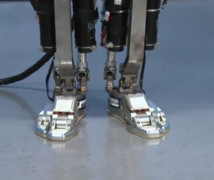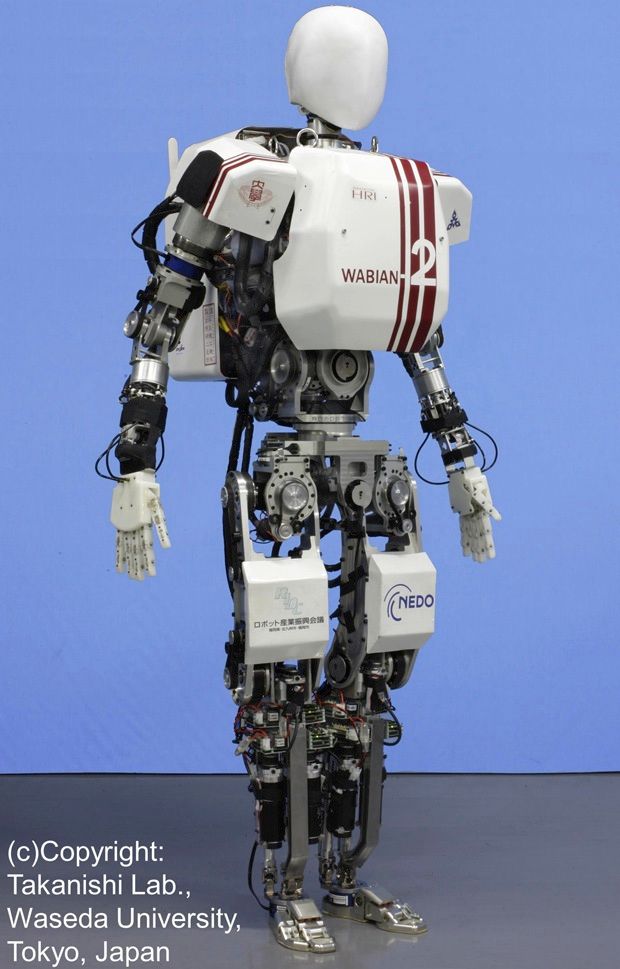/ News

Designing a More Human-Like Lower Leg for Biped Robots
Since bipedal robots took their first steps, the majority has been designed with the same basic joint/actuator configuration in their legs. This design, based on a simplified human leg, uses just six motors (three for the hip, one for the knee, and two for the ankle), and though it proved successful, it has also shown several limitations over the last 25 years. Now researchers at the Humanoid Robotics Institute at Waseda University (the birthplace of the first real humanoid robots) have set out to reinvent the wheel, er, the leg, by developing an entirely new shank that more closely replicates human walking.
The researchers, led by Professor Atsuo Takanishi, presented their groundbreaking work at the IEEE International Conference on Robotics and Automation (ICRA), early this month, in Germany. To design and test their new calf "muscles," the group started by taking a closer look at the legs of one of their robots: WABIAN-2R (WAseda BIpedal humANoid - No. 2 Refined) has been regarded as one of the world's most sophisticated humanoid robots since it was unveiled in 2006. It stands 148 cm (4 feet 10 inches) tall, weighs 64 kg (141 pounds), and, with its 41 degrees of freedom, can perform very human-like movements. What sets it apart from many other bipeds is its flexible pelvis, which gives it the ability to walk with stretched knees (unlike Honda's ASIMO, among others).

Most biped robots walk with flat feet that land parallel to the ground but WABIAN-2R's feet, with curving arch and flexible toes, lands heel-first and lifts off at its toes. That's progress, but a few vexing inconsistencies remain: humans walk with their feet roughly 90 mm (3.5 inches) apart, a distance doubled by the robot due to its large ankle motors. When walking, the robot's center of mass had a lateral movement of 50 mm (compared to just 30 mm for a human). And it couldn't mimic a person's foot rotation (approximately 12 degrees) due to a missing yaw joint in its ankle; a problem it and other biped robots inherited through the old joint configuration.
So with those limitations in sight, the Waseda researchers started working on their new leg. The missing foot rotation could come from the yaw axis in the hip, but that would also rotate the knee and just introduce its own set of problems. Instead, the researchers decided they would have to add a yaw joint somewhere below the knee, while at the same time shrinking the lower leg's overall size to shorten the step width between the feet. They began by looking at the average size and movement range found in humans, and analyzed motion-capture data to determine the optimal performance requirements of their new ankle.
In designing the prototype, the yaw rotation would be provided by a motor located at the top of the shin, just under the knee. The two motors normally situated in the ankle for pitch and roll were ditched in favor of a linear parallel link mechanism, which trimmed precious millimeters off the lower leg's circumference. Here is where they ran into their first major problem: there was no commercially available ball joint strong enough to withstand the compressive loads it would need to support. Their solution was to design one from scratch with the help of Japanese company Hephaist Seiko. (The project was supported in part by the Humanoid Robotics Institute, RoboSoM project, and Japan's MEXT.)

But the shank prototype's universal joints were causing problems and needed to be redesigned. Minor tweaks to the universal joints, and material changes, resulted in vastly improved stiffness and increased movable range. These and other refinements led to an entirely new system (pictured above, right). The researchers installed the new shank in their humanoid robot, which is now called WABIAN-2RIII.
This time, the robot worked marvelously. In experiments where it walked in place (see video above), not only was it able to match the human step time of 0.6 seconds, it also matched the required 12 degree foot rotation and 90 mm step width (see image below, right, showing the new design, and the one on the left, with the original robot, which had zero-degree foot rotation and 180 mm step width). The researchers have also successfully reduced its center of mass lateral movement from 50 mm down to 34 mm (just 4 mm shy of an actual human).

Next, the team plans on experimenting with forward walking, and reckon they can make adjustments to their existing walking pattern to achieve more realistic, human-like walking.
The researchers, T. Otani, A. Iizuka, D. Takamoto, H. Motohashi, T. Kishi, P. Kryczka, N. Endo, L. Jamone, K. Hashimoto, T. Takashima, H.O. Lim, and A. Takanishi, report their results in the paper, "New Shank Mechanism for Humanoid Robot Mimicking Human-like Walking in Horizontal and Frontal Plane," presented at ICRA in Germany.
Source: http://spectrum.ieee.org/automaton/robotics/humanoids/designing-a-more-humanlike-lower-leg-for-biped-robots
/ About us
Founded by Russian entrepreneur Dmitry Itskov in February 2011 with the participation of leading Russian specialists in the field of neural interfaces, robotics, artificial organs and systems.
The main goals of the 2045 Initiative: the creation and realization of a new strategy for the development of humanity which meets global civilization challenges; the creation of optimale conditions promoting the spiritual enlightenment of humanity; and the realization of a new futuristic reality based on 5 principles: high spirituality, high culture, high ethics, high science and high technologies.
The main science mega-project of the 2045 Initiative aims to create technologies enabling the transfer of a individual’s personality to a more advanced non-biological carrier, and extending life, including to the point of immortality. We devote particular attention to enabling the fullest possible dialogue between the world’s major spiritual traditions, science and society.
A large-scale transformation of humanity, comparable to some of the major spiritual and sci-tech revolutions in history, will require a new strategy. We believe this to be necessary to overcome existing crises, which threaten our planetary habitat and the continued existence of humanity as a species. With the 2045 Initiative, we hope to realize a new strategy for humanity's development, and in so doing, create a more productive, fulfilling, and satisfying future.
The "2045" team is working towards creating an international research center where leading scientists will be engaged in research and development in the fields of anthropomorphic robotics, living systems modeling and brain and consciousness modeling with the goal of transferring one’s individual consciousness to an artificial carrier and achieving cybernetic immortality.
An annual congress "The Global Future 2045" is organized by the Initiative to give platform for discussing mankind's evolutionary strategy based on technologies of cybernetic immortality as well as the possible impact of such technologies on global society, politics and economies of the future.
Future prospects of "2045" Initiative for society
2015-2020
The emergence and widespread use of affordable android "avatars" controlled by a "brain-computer" interface. Coupled with related technologies “avatars’ will give people a number of new features: ability to work in dangerous environments, perform rescue operations, travel in extreme situations etc.
Avatar components will be used in medicine for the rehabilitation of fully or partially disabled patients giving them prosthetic limbs or recover lost senses.
2020-2025
Creation of an autonomous life-support system for the human brain linked to a robot, ‘avatar’, will save people whose body is completely worn out or irreversibly damaged. Any patient with an intact brain will be able to return to a fully functioning bodily life. Such technologies will greatly enlarge the possibility of hybrid bio-electronic devices, thus creating a new IT revolution and will make all kinds of superimpositions of electronic and biological systems possible.
2030-2035
Creation of a computer model of the brain and human consciousness with the subsequent development of means to transfer individual consciousness onto an artificial carrier. This development will profoundly change the world, it will not only give everyone the possibility of cybernetic immortality but will also create a friendly artificial intelligence, expand human capabilities and provide opportunities for ordinary people to restore or modify their own brain multiple times. The final result at this stage can be a real revolution in the understanding of human nature that will completely change the human and technical prospects for humanity.
2045
This is the time when substance-independent minds will receive new bodies with capacities far exceeding those of ordinary humans. A new era for humanity will arrive! Changes will occur in all spheres of human activity – energy generation, transportation, politics, medicine, psychology, sciences, and so on.
Today it is hard to imagine a future when bodies consisting of nanorobots will become affordable and capable of taking any form. It is also hard to imagine body holograms featuring controlled matter. One thing is clear however: humanity, for the first time in its history, will make a fully managed evolutionary transition and eventually become a new species. Moreover, prerequisites for a large-scale expansion into outer space will be created as well.
Key elements of the project in the future
• International social movement
• social network immortal.me
• charitable foundation "Global Future 2045" (Foundation 2045)
• scientific research centre "Immortality"
• business incubator
• University of "Immortality"
• annual award for contribution to the realization of the project of "Immortality”.



 LinkedIn
LinkedIn
 LiveJournal
LiveJournal
 Google
Google
 Twitter
Twitter
 Facebook
Facebook
 Я.ру
Я.ру
 ВКонтакте
ВКонтакте
 Mail.ru
Mail.ru